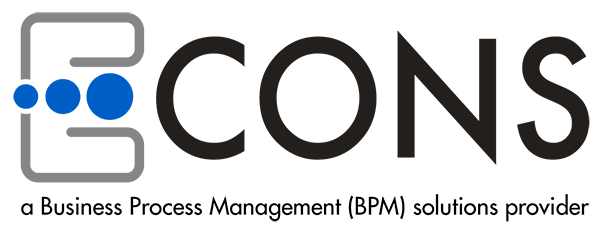Workflow Automation refers to the application of software tools to digitize and automate processes based on workflow rules where human tasks, data or files are routed between people or systems based on pre-defined business requirements.
Workflow Automation is a natural outcome of a process improvement effort which will in turn, boost your ability to further increase efficiency of the same process that was automated.
At ECONS we employ a comprehensive, systematic, and effective approach to business process automation that follows 4 stages:
Process Definition
- Definition of the automation scope: Agreement on the elements of the process will be included in the improvement effort.
- Establishment of the process KPIs: Selection of the key performance indicators of the process to be measured.
- Process review and ID improvements: Review of the process for alignment and the intent of identifying improvements prior to automating.
- Determinate the Documentation the “To Be” Process: Documentation of the finalized process flow with the improvements incorporated
Requirements Gathering
- Database platform selection: Selection of the database and resources needed based on the data characteristics.
- Establishment of Notification rules: Definition of Who, What, and When stakeholders need to be notified of a process event.
- User Interface platform selection: Definition of the general look, the feel, and the platform of the user interphase with the application.
- Design of KPI visual: Design of the graphs, dashboard, and data visualization needed for efficient and easy process monitoring.
Systems Design & Implementation
- Document Requirements: Formal documentation of all user requirements based on prior agreements
- Develop System/Application: Development of the application with periodic checkpoints to ensure alignment.
- Conduct user testing: Test the application by technical and end user resources in terms of functionality and usability.
- Document procedure and train users: Development of guides and procedures and user training to execute the task as intended.
Process Improvement Cycle (PDCA)
- Establishment of performance baseline and expectations: PLAN: Review of your process capabilities and define the short and medium performance expectations.
- Execution of process and data collection: DO: Monitor your process performance while it is executed and data is collected.
- Report and analysis of results: CHECK: Conduct process checks and KPI data reviews to identify trends and gaps to be closed.
- Definition of new process improvement actions: ACT: Define and pursue actions to close process gaps and/or add productivity.
It is important to keep in mind that the continuous improvement cycle will continue to yield new opportunities to automate new processes or make improvements to the process already automated, resulting from the increased visibility achieved. It is a benefit that will build on itself.
Contact us to find out how to assess your processes and identify automation opportunities.




